INTERVIEW: Palfinger CEO reveals business growth secrets
13 September 2023
Andreas Klauser, Palfinger CEO, talked to Alex Dahm about the company’s secrets of success and the latest developments in the business
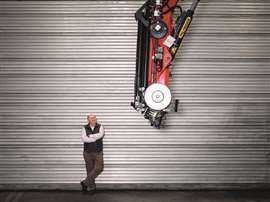 Andreas Klauser, Palfinger CEO. (Photo: Palfinger/philipphorak)
Andreas Klauser, Palfinger CEO. (Photo: Palfinger/philipphorak)
As a leading manufacturer of cranes and lifting solutions Palfinger is a well-known brand around the world. It is unlikely to have escaped notice that the company just seems to always be going from strength to strength, as borne out in its almost unbroken line of positive financial results over recent years.
In addition to articulating loader or knuckle boom cranes, the Austrian company manufactures telescopic crawler cranes, aerial work platforms, forklifts and other materials handling equipment.
Andreas Klauser has been chief executive at Palfinger since 2018. He talked to ICST editor Alex Dahm about the company’s growth and continuing development.
Alex Dahm: Just how does Palfinger keep on growing and breaking its own records; please let us in on the secret formula for ‘eternal growth’.
Andreas Klauser: The secret is that we really brought back customer focus, customer centricity, in terms of understanding what they need, what kind of products and solutions. In the past customers could tell you 90 per cent of their requirements for today, tomorrow, and in future. Currently they don’t even see how their equipment will be fuelled.
As a premium provider we need to think on that already for the next five years. When the customer receives a product in five years he can be sure that he has the proper solution. If it is hydrogen, electric or whatever, Palfinger will always provide a premium solution. This makes it a little bit more costly for us, a little bit more intense for us but, as a premium brand, we have the know-how in-house.
When we introduced our global market organisation, we created some centres of excellence. We have all this know-how bundled in the centre of excellence and all our product lines have access to this know-how, so the customer can be sure today, tomorrow, and in future, that they always get the right product and the right solution, meeting any requirements there might be in terms of regulations. That’s very important.
Secondly, we are really focused on the key areas where we do not only see short term potential growth but also long term in a sustainable manner. This is where North America kicks in. It is because we need to do more than a quarter of our revenue, maybe 30 per cent at the end of the day, in this economy of North America.
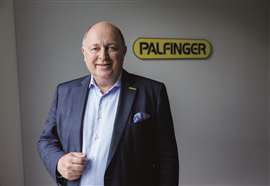 Andreas Klauser, Palfinger CEO. Photo: Palfinger/Peter Rigaud
Andreas Klauser, Palfinger CEO. Photo: Palfinger/Peter Rigaud
Therefore, we have set up our new headquarters in Illinois, to make sure we have the right focus in the area where we can really centralise all the forces we have among all the plants. Our US customers will really benefit a lot because the whole team is working together there. For any kind of solution, any kind of product line we are targeting, we have the know-how and the people there.
It is important to have this kind of centre of excellence where you bring all the forces together so you can really give the right answers to our customers and also support our dealers. Even with covid, war in Ukraine and many more Palfinger is so stable it can afford to invest in this. We had a record year in the year after Covid. Why? Because we still kept investing, even in the covid year, when others were retrenching and cutting budgets.
We went full speed through the waves. Our mindset is to be really proactive, to drive the business forward, not just waiting for what’s coming. Again, our vision and strategy is focusing on customer solutions and going digital.
We can do a lot in terms of digital, of optimised processes, loading processes, geofencing and so on. Also, we can make sure that even a low skilled workforce can operate our equipment in future. This will be a challenge not only in North America, it will be a global challenge. That is important.
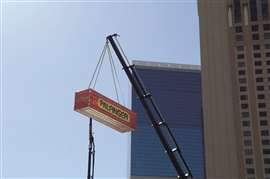 Palfinger is focusing on key areas where it sees long term sustainable growth, such as the USA. (Photo: Alex Dahm/KHL Group)
Palfinger is focusing on key areas where it sees long term sustainable growth, such as the USA. (Photo: Alex Dahm/KHL Group)
Constant growth
Alex Dahm: How much longer can it go on for where you continue to grow revenue year on year?
Andreas Klauser: Now a good thing here is that so far we did not acquire or merge with any new companies to get this revenue growth. It was one hundred per cent organic growth, based on the power and the stability we have in the different product lines.
It is very important that this large number of different businesses we are in, the huge variety of industries we are in, whether it is construction, forestry, waste management, whatever, – there is always one that is moving. Maybe one is slowing down, while another is going up. If we play this well, we can still grow.
We also find additional business with the new features and new solutions we are providing. Customers can be attracted from our current customer base but also from our competitors. This is one secret behind it because we are still maintaining our current customer base. Usually when you try to grow you look only for new customers but you still need to treat your current customer base very well. This is very important.
Again, we expect significant growth. In terms of costs, yes, there was an impact last year where we lost two points in terms of profitability but, considering the energy costs, the costs of materials, etc, it was still quite a good result. Our investors and our supervisory board reported they like it.
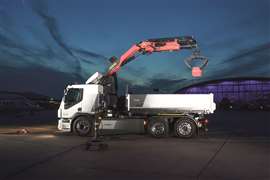 Palfinger’s PK 250 TEC loader crane. (Photo: Palfinger)
Palfinger’s PK 250 TEC loader crane. (Photo: Palfinger)
Making the investments
Alex Dahm: Regarding the recent expansion, in Germany and now in the USA, how much have you invested in these?
Andreas Klauser: Palfinger is investing several million euros in strengthening our sites and in ‘ecologisation’ and digitalisation projects to be well prepared to master the challenges of the future. Out of this we have completely refocused on North America, where we already have a broad sales and service network and 15 locations where we can have custom built solutions. The new headquarters is in Chicago. This will be the basis for our target to achieve a billion dollars in 2027, by the end of the year.
For North America, within the last two years we are close to a $20 million investment, between the plants and the new headquarters.
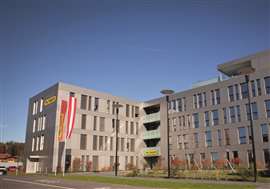 Palfinger’s HQ in Bergheim, Austria. (Photo: Palfinger)
Palfinger’s HQ in Bergheim, Austria. (Photo: Palfinger)
Alex Dahm: Is the new headquarters in Chicago similar in terms of the building and layout and everything to the new one in Germany?
Andreas Klauser: Yes, it is similar. We have administration and the team together. I’m a strong believer in teamwork and it suffered during covid. We will bring the entire team together at the new headquarters and then they can be more efficient, in parallel.
Alex Dahm: Efficiency is also a key theme at Palfinger. An example is striving to have parts and components common to multiple machines so you can carry a reduced inventory, tell us more about this and related initiatives.
Andreas Klauser: Exactly, common parts and higher modularity among the different products. Another area is technology we use in the background, for example, to have one system for data management, one system for the controls. This is what we are working on and it is one of our strengths.
You can also see how strong the Palfinger brand is. With our truck mounted forklift, for example, we managed to become one of the top two key players in the USA within six months of the product launch. The Palfinger brand stands really for performance, for a high quality, for a premium brand. And that is across all our product lines.
This leads back to what I said at the beginning and how sustainable is the company’s growth. There are still sufficient opportunities in other product lines.
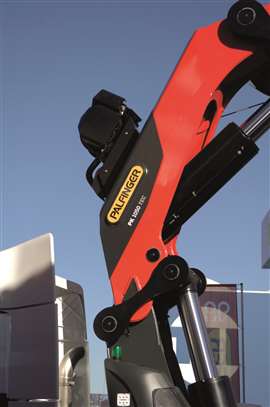 Close up of Palfinger's PK 1050 TEC loader crane. (Photo: Alex Dahm/KHL Group)
Close up of Palfinger's PK 1050 TEC loader crane. (Photo: Alex Dahm/KHL Group)
Lifting solutions
Alex Dahm: Where are things going in in terms of cranes? I know a typical approach might be to start with small models and then work your way up to the biggest ones at the top but bigger is not necessarily the way forward is it?
Andreas Klauser: No, it’s more about efficiency. In terms of manufacturing strategy, using maybe different materials. If you look at a crane, maybe in the future for sure this will be hydraulic but the extensions coming out might be electrified. We are thinking about these things but at the end of the day, we want to be the number one provider in terms of really having the proper solutions for our customers.
Alex Dahm: Following your expansion in Germany and the USA, where is next for similar development?
Andreas Klauser: We identified Latin America. And APAC is still looking quite good in certain areas. We are talking about Thailand. We are looking outside China now because it is heavily slowing down. We have been exploring opportunities in India, now a very fast-growing market. It’s moving away from handcrafted processes to really using technology. This is somewhere we can see room for improvement.
Alex Dahm: How is Palfinger faring against its competitors at the moment?
Andreas Klauser: We are lucky in terms of occupation, in terms of presence, in terms of focus, that they are still heavily internally focused, on how to redesign their organisations and so on. Luckily, we did this already in 2019 so we are more ready to deal with these upcoming challenges to be closer in the marketplace, closer to our customers.
Future fuel
While talking about Palfinger’s business performance and future direction, it was natural that the topic of energy to power this type of (usually) truck mounted crane should come up. Alex Dahm put the question to Andreas Klauser about hydrogen, a current hot favourite.
Alex Dahm: What do you see as the energy of the future for your cranes – do you think hydrogen is really likely as a practical fuel, for example, in combustion engines?
Andreas Klauser: It could be or it could play a part as a range extender. We have to see but we are open, we showed electric trucks and all the electrified equipment at the Bauma [construction equipment exhibition] and we got huge interest.
If it is coming or not, either way, we have to see when it’s coming. As a premium brand, our customers can be sure, whatever solution we provide, it’s always a premium solution. They can count on us.
We are not a follower. We know there’s a lot of competitors, other guys in the field, but they’re just following. They are just starting to engineer it when the truck to mount it on is already ready. We work in parallel with the truck manufacturer, working jointly to understand which kind of technology is the way forward.
For hydrogen a very specific design for mounting a crane behind the truck cab might be required because if you have hydrogen trucks you will lose about 1.5 metres from that area for the storage of hydrogen. So, the entire geometry of the truck will change. We are working on this.
STAY CONNECTED


Receive the information you need when you need it through our world-leading magazines, newsletters and daily briefings.




